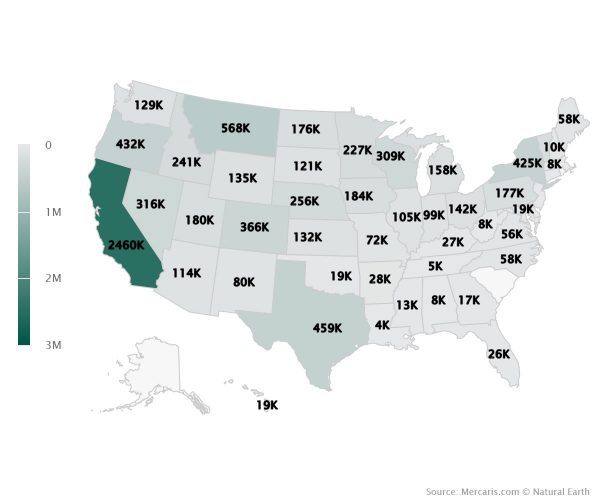By Henry Wilson, economist, Mercaris
Organic agriculture continues to grow year after year, becoming a larger part of the food and agriculture industry. This did not slow down in 2021, as the amount of organic acres in the U.S. is expected to grow at a steady rate. The continued growth of total operations and harvested acres—along with quality yields for many crops— is expected to lead to one of the largest U.S. organic harvests on record. This bodes well for the organic industry both in 2021 and going forward.
Per Mercaris’ recently updated Acerage Analyzer, total organic acres harvested this year are up over 5% from 2020. This comes from an anticipated increase in almost all organic crops, including almost every field crop. The largest percent increase in field crops comes from pulses, mostly driven by the increase of organic dry beans and lentils grown in Montana. Also, large increases in wheat, corn, and soybeans are anticipated. Harvested acres of organic corn for grain are expected to increase almost 4% year-over-year, as well as a 6.5% increase in organic wheat, and more than a 10% increase in organic soybeans. The only field crop that is expected to see a decrease in acres harvested in 2021 is organic tobacco, which is expected to decrease by more than 11%. Total acres harvested for organic field crops in 2021 are estimated to reach more than 3.6 million, which is a greater than 7% increase from 2020. This is led by an estimated 1.1 million acres of organic alfalfa and hay, nearly 700,000 acres of organic wheat, and 450,000 acres of organic corn across the country.
California continues to lead the U.S. in organic crop production. California’s total organic acres are expected to increase by more than 5% year-over-year, bringing their total organic harveted area up to 2.5 million acres, and accounting for over 25% of U.S. total organic acres. The only state in the top ten of ogranic production that is expected to decrease in 2021 is Wisconsin, mostly due to a decrease in organic corn acres. Overall, organic acreage is expected to increase across all regions of the country in 2021, dispite some reductions in some states.
Unlike most of the organic crops, non-GMO crop acres saw a decrease in 2021. Non-GMO corn saw a 6.8% decrease in planted acres in 2021 driven by a 33% decrease in harvested acres in Iowa, the leading state in non-GMO corn production. Non-GMO soybean production also saw an 11% decrease in 2021 driven by large decreases in acres in Minnesota, Iowa, and Ohio.
What can be seen in the acreage analyer paints a positive picture for organic agriculture, as we continue to see positive growth across a majority of the crops and states. The demand for organic products continues to grow, and this continued growth of the U.S. supply points to a healthy growing industry for organic production as a whole.









